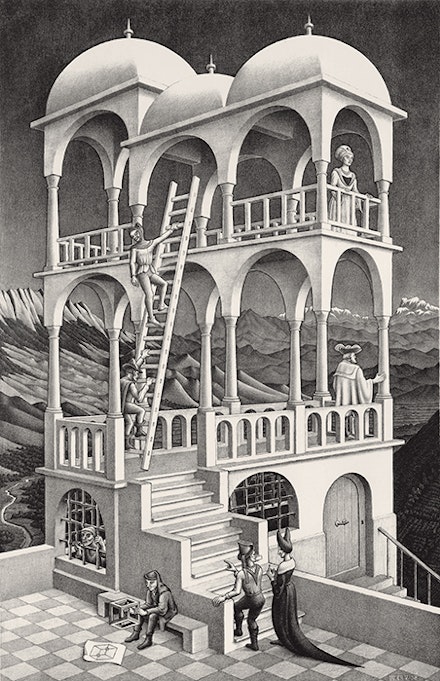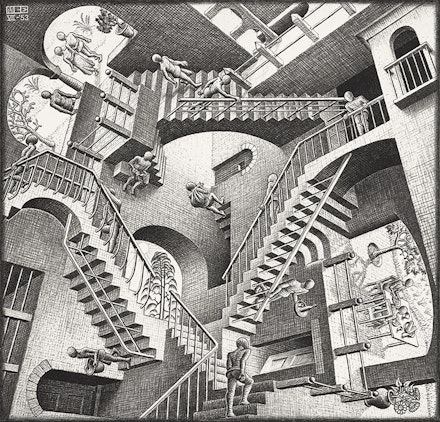ArtSeen
THE WORLDS OF MC ESCHER
Nature, Science, and Imagination
Although seemingly ubiquitous in pop culture, MC Escher is not accorded much weight in more traditional fine-art circles. This is, perhaps, because he is something of a flash in the pan: he is not associated with any major art movement—despite some seeming sympathies with the Surrealists—nor did his work inspire many subsequent visual artists. It is, though, wildly popular; a retrospective of his at the National Gallery in 1997 – 98 was the museum’s most attended show ever, and his work has influenced geometers, filmmakers, and cognitive scientists. David Steel, curator of European Art at the North Carolina Museum of Art has brought together 130 works by Escher; it is the largest collection to be publicly assembled in the United States.
On View
North Carolina Museum Of ArtOctober 17, 2015 – January 17, 2016
North Carolina
We most often encounter Escher’s work in posters, one at a time, and outside of much context. This is somewhat appropriate, as the work itself is generally without context—strange and self-contained worlds of impossibility that delight the eye and mind while leaving the heart unmoved. This head-heart disconnect, I imagine, is what led Roberta Smith to label Escher “art for beginners” in a 1998 Times review of the National Gallery show (although whether this accessibility is bad for a museum is another story). Seeing his oeuvre assembled here, though, gave one reviewer a much different impression. Consistent remove from the troubles of early 20th century Europe, from the foibles of mankind, reads not as simple kitsch but instead as a telling choice in the face of a difficult world.
There is a dark side to Escher’s work that a quick dismissal misses. Death is a recurring theme, starting with his leering Skull with a Cigarette (1917), and his delicate 1939 pencil sketch of his father on his deathbed—his father died later in the day—is one of the more surprising, and poignant, works in the show. Describing the skull in the center of his 1946 print Eye, Escher refers to “Good Man Bones, with whom we are all confronted, whether we like it or not.” With Mr. Bones lurking in the background, Escher’s bizarre empty worlds, his focus on form and shape at the expense of a warmer humanism, seem to deal with questions of mortality by creating Ouroboroses which, through tricks of recursion and impossible circularities, can sustain themselves forever. Thus does he cure the patient—mortality—by killing him.
Indeed, from the outset, the human figures in Escher’s work are usually either twisted and devilish or faceless and trudging, and are not the real stars of the show; this pattern reads less like misanthropy than disinterest in exploring humanity. In his juvenilia, and through a middle period in Italy—spent roaming the countryside by foot and donkey to make sketches for later prints—form takes central billing: sharply contrasted stairs shoot out akimbo from central streets, olive trees whirl in placid spirals, ripples on water repeat sharply and evenly. The patterning and landscapes are fun viewing, but typically offer little beyond that.
Many of his studies from his time in Italy reappear in his later works: stairs, lizards, praying mantes, the blocky buildings of Italian towns. This early period also includes a series of dreamlike prints, perhaps his most emotive works. Castle in the Air (1928) shows a princess sitting atop a giant turtle in an endless black lake, cut by white ripples. Her arms stretch upward toward a chiaroscuro-walled castle on a rocky island in the night sky. Nearby hangs La Cathédrale Engloutie (The Sunken Cathedral) (1929), wherein a sailboat glides toward an opulent cathedral sinking into the sea. The work would be at home on a Miyazaki film set, or as a setting for a Garcia Marquez story.
In 1935, though, the rise of fascism in Italy pushed Escher and his family out of the country. A visit to the Alhambra in Granada and other Moorish relics in Spain ignited his love for tilework and patterning of flat surfaces—thus began the mature phase of his career. This is the portion of Escher’s work that so excites mathematicians and the puzzle-minded: he toyed with the planar and the spatial, with forms jumping from flat designs into space and back. He created fractals of shapes that repeat themselves until infinitesimally small, seamlessly jumbled multiple perspectives of the same scene into prints, and dreamed up strange loops of shapes morphing into one another like visual word ladders. A physicist and a doctor wrote catalogue essays for the show, indicating the reach of his metaphysical puzzles beyond standard art historical territory.
Even so, the thrust of the work conveys a universal human wish: to escape the terror of death. I read Escher’s retreat into intricate formalism as a response to the horrors of his time: the rise of fascism in Europe and World War II. The bizarre and surreal quality of much of the work, the mind-bending illusions juxtaposed into mostly recognizable settings, create a sense of inquietude and uneasiness about our world, mirroring Escher’s most certainly unquiet surroundings. Either we can break with reality and find solace in Escher’s dream-worlds, or we can spin ourselves into self-contained loops, isolated from the chaos outside. Locked in twisted tedium, the human condition seems absurd here. Why not then take solace in the perfection of form? Monks trudge endlessly upward only to end up where they began. Shapes burst into being and retreat into the void. We look at prints of ourselves looking at prints of ourselves. The center cannot hold. But it is formally airtight.




